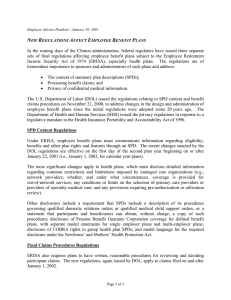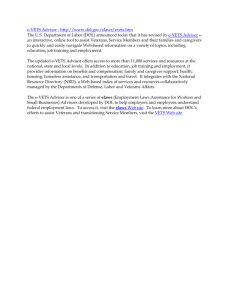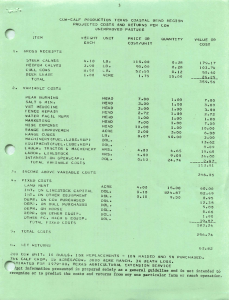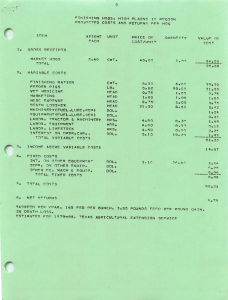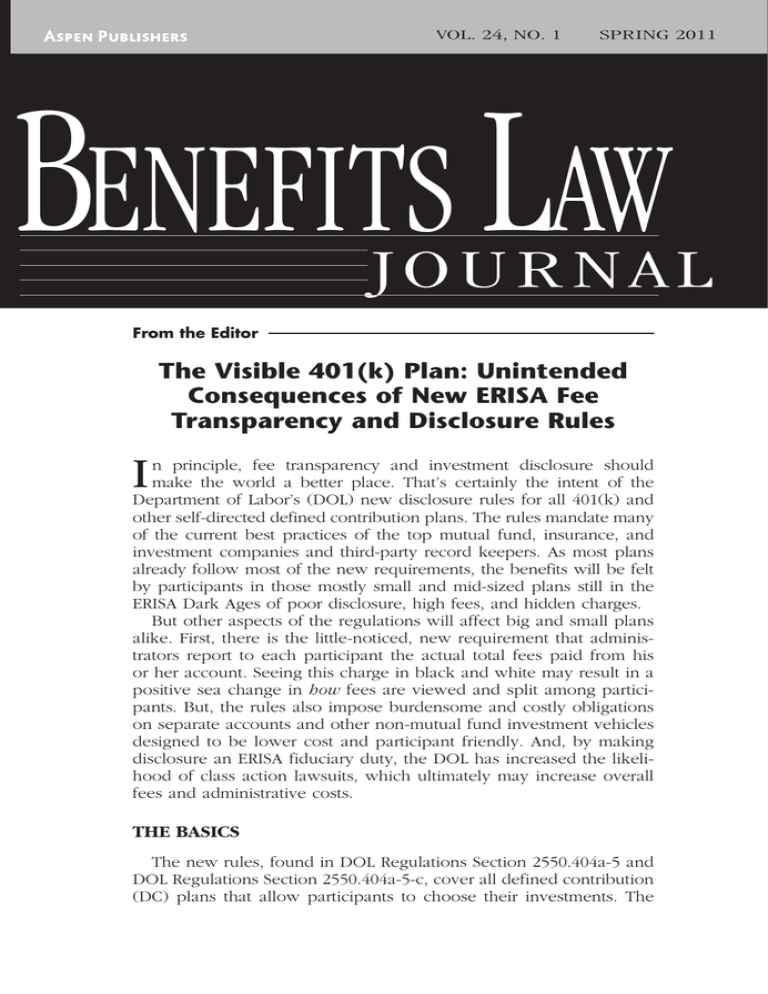
VOL. 24, NO. 1
SPRING 2011
BENEFITS LAW
JOURNAL
From the Editor
The Visible 401(k) Plan: Unintended
Consequences of New ERISA Fee
Transparency and Disclosure Rules
I
n principle, fee transparency and investment disclosure should
make the world a better place. That’s certainly the intent of the
Department of Labor’s (DOL) new disclosure rules for all 401(k) and
other self-directed defined contribution plans. The rules mandate many
of the current best practices of the top mutual fund, insurance, and
investment companies and third-party record keepers. As most plans
already follow most of the new requirements, the benefits will be felt
by participants in those mostly small and mid-sized plans still in the
ERISA Dark Ages of poor disclosure, high fees, and hidden charges.
But other aspects of the regulations will affect big and small plans
alike. First, there is the little-noticed, new requirement that administrators report to each participant the actual total fees paid from his
or her account. Seeing this charge in black and white may result in a
positive sea change in how fees are viewed and split among participants. But, the rules also impose burdensome and costly obligations
on separate accounts and other non-mutual fund investment vehicles
designed to be lower cost and participant friendly. And, by making
disclosure an ERISA fiduciary duty, the DOL has increased the likelihood of class action lawsuits, which ultimately may increase overall
fees and administrative costs.
THE BASICS
The new rules, found in DOL Regulations Section 2550.404a-5 and
DOL Regulations Section 2550.404a-5-c, cover all defined contribution
(DC) plans that allow participants to choose their investments. The
From the Editor
rules apply whether or not an employer wants to take advantage of
liability protection under ERISA Section 404(c) for participants’ own
poor investment decisions, essentially replacing Section 404(c)’s voluntary safe harbor with a new set of fiduciary obligations.
Thus, starting with the 2012 plan year (or November 2011 for plan
years that start in November), plan administrators must furnish all
participants (including non-contributors with zero balances) with a
schedule of expense ratios and other investment fees; service charges
for processing loans, withdrawals, QDROs, and the like; and planlevel charges for legal and administration costs that are not otherwise
covered by investment fees. In addition, participants must be informed
of their investment choices; investment performance history (including benchmark comparisons) over one-, five- and ten-year periods; an
investment glossary; “Bogle-like” (the Vanguard founder and patron
saint of low-cost investing) comments on the impact of fees on retirement savings; and access to a Web site with additional details.
This information must be provided before a participant starts investing
in the plan and annually thereafter. And, in what can only be described
as wanton bureaucratic cruelty, participants must be notified within 30
to 90 days prior to any change being made. For example, if a plan’s
holdings in a particular mutual fund grow large enough to qualify for
a lower share class, the fees cannot be lowered until participants have
had at least 30 days to digest this information. However, in a burst of
generosity, the DOL does not require separate breakdowns of any revenue sharing or 12b-1 fees included in a fund’s expense ratio. Instead,
participants need only be told that some of the plan’s administrative
expenses are paid from some of the fund fees. This is a fair requirement that will not confuse participants with information overload over
how the expense ratio is divvied up among plan vendors.
WILL PARTICIPANTS NOTICE THE CHANGES?
My own unscientific but broad-spectrum survey of record keepers
used by clients and colleagues reveals that most of the required information disclosure was already widely available online to plan participants. For many participants, the new rules will change only the format,
timing, and location of the disclosure, not its scope. However, not all of
it is necessarily included in the paper statements and, even on the Web,
it may require multiple clicks to dig into details such as expense ratios
and investment benchmarks. The new rules do usefully require providing all this information in one place, directly to participants without
their having to ask for it (or even know it exists). Folks who take the
time to study this information will discover an array of basic investment
information is now at their fingertips. However, for the many participants who routinely toss or delete their quarterly statements, the added
convenience of the new format will be meaningless.
BENEFITS LAW JOURNAL
2
VOL. 24, NO. 1, SPRING 2011
From the Editor
WHAT INFORMATION IS TRULY NEW?
Come 2012, there will be one huge difference in participants’ quarterly statements that should jump out to anyone paying attention: a
participant’s total investment fees. This is important because of the
way most participants perceive their plan costs. To many employees,
a 1 percent expense ratio doesn’t sound like much and may not even
be viewed as an out-of-pocket expense. In contrast, informing someone with a $400,000 plan account balance that he’s paying $1,000 in
quarterly investment charges is likely to register loud and clear.
How folks will react to this additional fee information is anyone’s
guess. The DOL is hoping participants will start haranguing their
employers and record keepers over the fee levels and move their savings into low-cost index funds. Indeed, an unstated intent of the new
rules is to steer participants toward index funds and away from more
expensive, actively managed products. While this may conform to the
thinking of many academics and professionals, others may question
whether it’s within the DOL’s role or expertise to favor a particular
investment strategy.
Once total fees start showing up in quarterly benefit statements,
many employees may realize that their retirement plan is not “free”—
rather, they are paying for the toll-free number, Web site, investment
education, and general 24/7 access to account information plus the
costs of complying with the myriad of tax and ERISA regulations. The
loudest screams may come from higher-paid, longer-tenured employees with substantial account balances. These participants may realize
that not only are they paying significant amounts, they are subsidizing
fellow plan participants with smaller balances or in lower-cost funds.
After all, it doesn’t cost any more to maintain records on a $1 million
account than one of $10,000. And, because index funds and some
other plan investment offerings may not engage in revenue sharing, people investing in these funds do not contribute at all toward
recordkeeping.
This eye-opening disclosure could pave the way to alternative
fee arrangements in which recordkeeping and investment costs are
charged separately. Investment fees could be lowered, while each
participant’s account would be debited a quarterly recordkeeping
charge—say the lower of 15 basis points (.15 percent) or $20. Each
participant would thereby pay his or her own way, with any 12b-1
fees or revenue sharing being returned to the participants’ accounts
investing in the funds that generated these amounts. Ironically,
imposing a 15bp recordkeeping charge would actually increase costs
for those investing in index funds, which typically do not engage in
revenue sharing. Until now, employers found this type of alternative
structure difficult to impose because participants believe their 401(k)
program is free. By correcting this common misperception, the DOL
BENEFITS LAW JOURNAL
3
VOL. 24, NO.1, SPRING 2011
From the Editor
will make it feasible for employers to consider an “everyone pays his
or her own way” system and other equitable and reasonable methods
of sharing administrative costs.
Unfortunately, the new rules also will give some participants only
enough new information to be dangerous to themselves. For example,
employees participating in a new or small plan (where the fees are
likely to be higher) may be discouraged from contributing. Or, some
former employees will mistakenly try to avoid their DC plan fees
by withdrawing their money or rolling over their accounts to IRAs
which—because they aren’t required to disclose fees in this manner—
may appear to be “free.” Similarly, the DOL did not impose fee transparency on certain guaranteed investment contracts and other interestgenerating, guaranteed insurance, or annuity products, which may
also seem fee free and a better investment deal than other funds.
PLANET WASHINGTON
Before getting to the bad news, I’d be remiss in my editorial duties
without reporting that the DOL projects that better disclosure will save
participants an astonishing 54 million hours now spent searching for
this same information, adding $14.9 billion to the US economy. Perhaps
this would be the case in an alternative universe, where most participants had actually bothered to look up this information, and will now
devote their newfound free time to economically productive activities.
THE BAD NEWS
Alas, the new rules are destined to increase plan costs in at least
two ways. First, according to the DOL’s own estimate, it will cost
record keepers over $2.7 billion to reprogram computers, reformat
benefit statements, and make other administrative changes. I’d suggest adding to this total the “hidden” costs of delays, and confusion
in notifying participants within the 30–90-day window allowed for
fee and other changes. I wonder how many fee reductions will be
delayed to give the mandatory 30-day advance notice.
The costs of retooling will likely be even higher for the many
plans that offer separate accounts or commingled investments. The
new rules were written as if all plan investment vehicles were mutual
funds. But many of the larger plans and some financial institutions
have created their own investment offerings by selecting money managers, developing investment guidelines, and building a custodial/
recordkeeping infrastructure. These vehicles allow more control,
access to a wider array of investment professionals, and reduced fees,
among other possible benefits. Because the new DOL guidance is
“mutual fund–centric,” it will take extra money and effort to build the
necessary systems and Web sites for these other investment vehicles.
BENEFITS LAW JOURNAL
4
VOL. 24, NO. 1, SPRING 2011
From the Editor
The other new costs are more insidious: increased litigation and
the wasteful “defensive” practices that employers, investment firms,
and record keepers will adopt to reduce their exposure. The DOL has
effectively elevated a disclosure error to a violation of the ERISA fiduciary duties of prudence and loyalty. Yet the reality is that plan administration is extraordinarily complex and mistakes inevitably are made.
Now, when a statement or notice is late, a fee or performance data
is miscalculated, a schedule is omitted, or a similar glitch occurs, the
plaintiff’s bar will be ready to argue (especially if the plan is large) that
the mistake caused his or her clients to invest too aggressively or conservatively, depending on the particular investment market. The DOL
disingenuously maintains that the regulations aren’t intended to make it
easier to sue, but in fact they create an entirely new fiduciary obligation
and give class action lawyers another legal weapon in their arsenal.
PARTIAL DO-OVER
The DOL has added a number of sensible requirements to enable
participants to get a better understanding of the fees they are paying
and their DC plan investments. This good is largely undone by the
higher costs of compliance for non-mutual fund investment vehicles
and, more significantly, the litigation Pandora’s box opened by the
DOL turning a simple disclosure mistake into a full-blown ERISA fiduciary violation. As the government well knows, these costs ultimately
will be reflected in higher recordkeeping and administrative fees and
passed through to participants. Although the regulations are final,
it’s not too late for a partial “do-over” to correct these policy errors.
Otherwise, the DOL will have given participants a better view of the
higher fees they’ll certainly be paying.
David E. Morse
Editor-in-Chief
K & L Gates LLP
New York, NY
Copyright © 2011 CCH Incorporated. All Rights Reserved
Reprinted from Benefits Law Journal Spring 2011, Volume 24,
Number 1, pages 1-5, with permission from Aspen Publishers,
Wolters Kluwer Law & Business, New York, NY, 1-800-638-8437,
www.aspenpublishers.com
Law & Business
BENEFITS LAW JOURNAL
5
VOL. 24, NO.1, SPRING 2011


